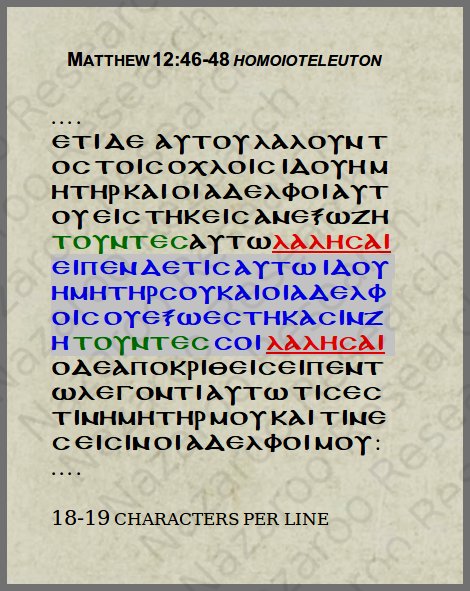INTRODUCTION
Mistakes and Text-Types
Deliberate Changes
Deliberate alterations to the text can be a result of common theological influences operating independantly, or they can be simply imported artificially between text-types and genealogical lines. Thus they are unreliable indicators of either text-type or genealogical dependance, even when they are perpetuated by copying.
Accidental Alterations
On the other hand, accidental errors can indeed be used to show genealogical dependance, and classify manuscripts into text-types, if these errors are of a kind that would be missed, and then perpetuated in further copies.
Haplography
The peculiar error of haplography (accidental omission) is just the ideal type of error to establish genealogical relationships and offer stable features of a text-type. An error of haplography is likely to be copied unnoticed, especially if the material dropped has no special value or theological impact. It has the further advantage of being rather easy to spot and having unambiguous features: useful cases will have a combination of likely Homoioarcton (similar beginning of a line), Homoioteleuton (similar ending), plus a lack of theological or doctrinal signficance to the omitted material.
Haplography
in Critical Greek Texts
Of some 35 places in Mark where the critical Greek text departs from the traditional text significantly, deleting whole or half verses, almost a third are obvious cases of haplography. The manuscript evidence is also just what we would expect and require for these cases to be clinching.
Why critical Greek Texts Contain Errors
This is not an 'error' in procedure per se, to publish a critically reconstructed text, since one can reconstruct an earlier common (lost) archetype using 'agreement in error' between manuscripts. Such a text will necessarily contain the errors identified as copied from the extrapolated source to the extant MSS.
Westcott & Hort no doubt succeeded in reconstructing an early, error-ridden archetype for Aleph and B, possibly originating in the late 2nd or early 3rd century. (Since then, even earlier MSS that have been recovered that diverge from the text of this ancestor).
This text (Hort's hypothetical ancestor for Aleph and B) however should then have been corrected by carefully eliminating all known accidental errors of the haplographic type, before any further application of the text to 'correct' other texts is to be made.
Why Modern Versions should NOT Follow Critical Texts
It is a mistake however, to adopt the plain errors of any intermediary text in a finalized printed Bible, since the whole end goal of textual criticism is to eliminate errors, not re-introduce errors into the text, however ancient they may be. Thus using an 'unedited' critical Greek text is an enterprise in futility, and a clumsy misuse of valuable tools for the improvement of Bible accuracy.
Matt. 12:46-47 (traditional text)
homoioteleuton
.................................................ε τι δε αυτου λαλ-
ουντος τοις οχλοις ιδου η μητηρ .....και οι αδελφοι
αυτου ειστηκεισαν εξω ζητουντες αυτω λαλησαι
ειπεν δε τις αυτω ιδου η μητηρ σου και οι αδελφοι
...σου ..εξω εστηκασιν ..ζητουντες ..σοι λαλησαι
.............................................. While he
yet talked to the people, see; his mother and his brethren
stood outside, desiring with him to speak.
Then one said unto him, see; thy mother and thy brethren
outside stand, desiring with thee to speak.Include Verse: א(corr.a) Θ Π 0112 0250 family 1, family 13, 28 33 565 700 892 1010 1071 1079 1195 1216 1230 1242 1253 1344 1365 1546 1646 2148 2174 Byz Maj (Majority of continuous MSS) lect.-333 it-a/aur/c/d/f/ff2/g1/h/l/q Vg Syr-P/H Cop-Bo Goth Arm Eth Geo Diatessaron Origen Chrysostom
Omit: א* B L 1009 l12 it-ff1 Cop-SaNever could four lines of coupled pairs be more prone to a haplographic error of the first kind. A spark from the fireplace or a sneeze may have been enough to distract the copyist's glance, and so skip two more sacred lines of text.
And the early Egyptian copyist does not disappoint. He indeed stumbles past the 2nd verse, in his desire to finish and exit the baking copying-room in 110 degree desert weather, to enjoy a well-deserved and refreshing plunge in the cool Nile waters. Whether he was subsequently eaten by a crocodile, we will never know.
If all these haplographic boners were actually Byzantine "expansions" of the text, as Hort imagined, then our frantically driven text-bloaters were the most unimaginative ad-libbers ever born, and must have had the intellects and attention-spans of 1st graders. But then how in that case did they have the cunning to consistently disguise their work as homoioteleuton errors? Surely the theory gives these verbose, babbling madmen far too much credit.
Hort himself dared not completely excise this verse ( Matt. 12:47 ), and Nestle and USB timidly bracket the embarrassing gaffe, (betraying the true nature of all the other errors found in Aleph and B). The brash Revised Standard Version, Moffat, and Goodspeed eagerly strike out the text, hoping to be rid of yet another wordy passage. What Alexandrian editor confronted with Matthew's stilted, redundant but faithful recitation, wouldn't pounce on a shorter text, no matter what the original cause? And modern editors follow suit.
Yet if we continue this way, reinstating every omission in every ancient manuscript, our NT would quickly look like Swiss Cheese, and be about as readable as a Scientology lecture, or a gem from Madame Blavatsky.
S.W. Whitney analyzes both verses as follows:
Matt. 12:46
η μητηρ και οι αδελφοι αυτου ειστηκεισαν εξω ... (TR/AV/WH!)
η μητηρ και οι αδελφοι ..... ειστηκεισαν εξω ... (RV)
- "his mother and [his] brethren stood outside..."
The omission of αυτου, "his", from the Greek text is a wholly unnecessary alteration, affecting the English version in no way whatever, not even with italics. Why it should have been made is more than we can understand; for it is favored only by the 6th-century emendator of the Codex Sinaiticus (א), by Z and 3 cursives, 7 copies of the Old Latin Version, and a single passage in Origen & Chrysostom each ;
Whereas, its presence is called for by the original scribe, as well as the earlier 7th-century corrector of א, by B, C D E F G K, L, M, S, U, V, X, Γ, Δ Π, and all the other codices; versions, and Fathers. It is bracketed by Lachmann as a possible interpolation, but is accepted as genuine by Westcott & Hort, Tischendorf, and other editors.
Matthew 12:47
A marginal note says that "some ancient authorities " omit this verse. These authorities are א first hand, B, L, Γ, four cursives, two copies of the Old Latin, and the Curetonian Syriac Version. Those who regard these manuscripts and versions as presenting the original text, conclude, without any other reason for so doing, that the verse is an interpolation from Mark 3:32, or Luke 8:20.
Westcott & Hort omit it from the text, though they have it in the margin. But nearly all other editors accept it as genuine, or probably so.
The testimony against it is by no means sufficient to call for its rejection. In fact, the hand that tampered with the longer reading in Matt. 1:25 seems very plainly to have been at work here and on the αυτου of the preceding verse, trying to eliminate from this Gospel all traces of the fact that Mary had more than one son. The emendator, having stricken out αυτου from verse 46, and omitted verse 47, could very well afford to continue, in Matt. 12:48, the presence of μου in connection with αδελφοι (though B first hand omits it), because, in Matt. 12:49-50, Christ makes the expression mean others than brothers by birth. But to have a by-stander say to Jesus, "Thy mother and thy brothers stand without" etc. was too much for our ancient critic; and so he rejected the whole verse. Yet the αποκριθεις, "answered", and τω ειποντι αυτω, "him that told him" of verse 48, make an uncomfortably suspicious and unaccountable reading if this verse is omitted.
Other possible formats for the miscopied exemplar could include column widths such as these:
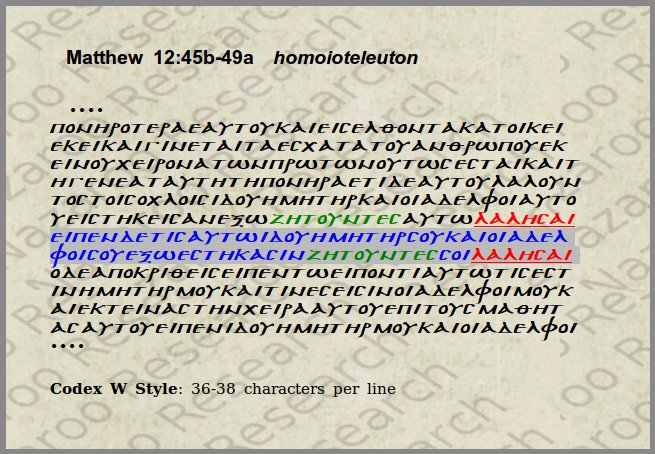

Matt. 15:6 (traditional text)
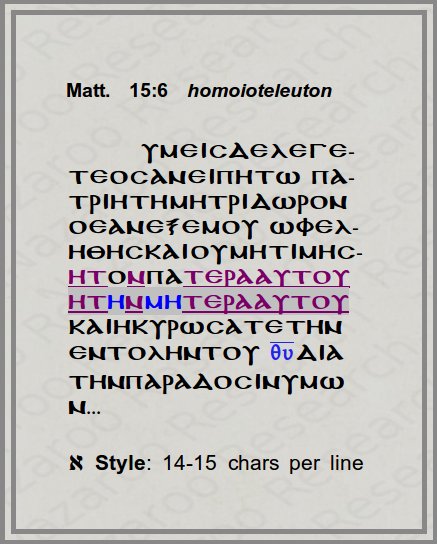
και ου μη τιμησ-
η τον πατερα αυτου
η την μητερα αυτου
"...and does not hon-
-or his father
or his mother
INCLUDE LINE: C K L W X Δ Π 1009 1010 1079 1195 1230 1242 1253 1344 1365 (1546) 1646 2148 2174, Byz Maj (Majority of MSS), Lect (all Lectionaries), it-aur/f/ff1, vg-cl, Syr-s/p/h, Cop-Bo?, Arm Aeth Diatess.-Csyr, Origen Cyril
(omit: 1st "autou") f1, l-184, Geo-B, Origen?
(omit: 2nd "autou") 084 f13, 33 700 892 1071 (1216)
(subst: KAI) it-ff2/g1/l, vg-ww, Chrysostom Jerome Cyril
OMIT: - א, B, D, it-a/d/e, Syr-C, Cop-Sa, Geo-1
When we can see a difference of only three letters between successive awkward clauses, the Haplography alarm-bell should be going off loudly in the back of our heads. Notice the phrases are longer in Greek than in English translation (usually its the other way round). A bit of tiredness, and this adverbial modifier vanishes from a textual stream of transmission easily.
Once gone, no Alexandrian editor is going to willingly re-insert what looks like a redundancy (see verse 5 preceeding).
The awkwardness of the Greek (probably 'translation-Greek') is acutely felt here, as evidenced by at least four minor variations, all attempts to smooth the phraseology over. No wonder that a Haplography lapse was pounced on and reproduced further downstream. The full weight of the majority of every independant source of transmission is obscured by the minor variants, and the way they are listed separately in UBS-2.
Nestle rightly rejected this accidental omission, but UBS-2 follows Westcott/Hort, again presuming the omission to be original rather than an early ancestral error. Modern versions are left confused, with the American Standard Version (ASV), NIV and Revised Standard Version (RSV) omitting, while others retain the traditional text. Some later revisions of modern versions have restored the text.
Matt. 15:8 (traditional text)
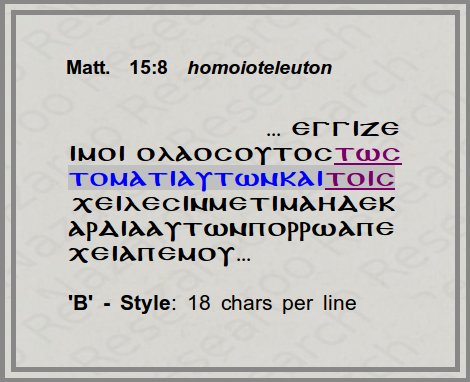
εγγιζει μοι ο λαος ουτος
ΤΩ ΣΤΟΜΑΤΙ αυτων και
ΤΟΙΣ χειλεσιν με τιμα η
δε καρδια αυτων πορρω
απεχει απ εμουThis people draws near to Me (with)
the mouth of them and (with)
the lips honours Me,
but their heart is far
away from Me!
INCLUDE LINE: C, W,Δ 0106, f13-part, Byz Maj (Majority of MSS), f, q, Sy-H etc.
OMIT: - א, B, D, L,Θ 073, 124, 788(=f13-part), 33, 579, 700, 892, 1424, pc, Lat, Sy-S/C/P, Copt(+ mae-2), Egerton 2, Clement, Origen, Didymus
Special Note:: B: has an umlaut! (a text-critical marking at line 39 A, p. 1255 : λαος ουτος ...ΤΟΙΣ χειλεσιν )In the old UNCIAL (capital letter) style of writing, many letters appeared similar which do not appear the same in modern printed (small letter) texts of the New Testament. This is one of those cases where the Haplography features are quite obvious in an UNCIAL text, but difficult to spot using a modern cursive font.
The Letter Omicron (short "o" O) and Omega (long "o" Ω) in UNCIAL letters are very similar, as close as a capitol O and Q would be in English block letters. Uncial manuscripts were most often written without large spaces between words, in an effort to fit more on the page, and small strokes like "I" could often be faded or lost or taken for part of another adjacent letter.
Here a similar stretch of letters at the beginning of two lines resulted in the accidental loss of the first line.
This omission/variant is left undocumented in both Nestle and UBS-2/3, although it was noted in Westcott/Hort's original notes and "Introduction".
The text-critical umlaut found in Codex Vaticanus (B, ms#1209) shows that the copyist of this manuscript was well aware of the dropped line, but faithfully copied the exemplar he was instructed to copy. In this manuscript, many hundreds of umlauts mark text-critical variants, and Codex B carefully notes the many places his exemplar departs from the common text using this technique.
Again, "modern" versions almost universally drop the half-line, because they are following the UBS text without much concern for its many undocumented differences from the Traditional text of the NT used by Christians for over a thousand years. One more time, an ancient error long abandoned has been allowed to creep back into the Biblical text undocumented.
Matt. 17:20-22 (traditional text)
The omission of Matthew 17:21 is undoubtably yet another Haplography error, but the excuse for it is so slim that the variant almost defies classifying, and we must leave about an 80% chance of pure fatigue and incompetance as the real cause:
πιστιν ως κοκκον σιναπεως ερειτε τω ορει
τουτω μεταβηθι εντευθεν εκει και μεταβησ-
εται και ουδεν αδυνατησει υμιν
τουτο δε το γενος ουκ εκπορευ-
εται ει μη εν προσευχη και νηστεια
αναστρεφομενων δε αυτων εν τη γαλιλαια
ειπεν αυτοις ο ιησους μελλει ο υιος του
ανθρωπου παραδιδοσθαι εις χειρας ανθρωπων
...faith the size of a mustard seed, you'll say to
this mountain, `Move from there,' and it will move
out; and nothing will be impossible to you:
this kind however, does not go
out if not by prayer and fasting."
And while they were gathering
together in Galilee, Jesus said to them,
"The Son of Man is going to be delivered
into the hands of men;
Include Verse 21: All the rest...Byz Maj (Majority of MSS), etc.
Omit: א, B Θ 33 892(txt) it-e/ff1 Syr-C/S/Pal Cop-Sa/Bo(mss) Eth(mss) Geo Euseb.What can be said? The ancestor of Aleph/B is again guilty of a blunder. The haplographic features are a poor excuse, but not non-existant.
Hort, Nestle, UBS all omit the verses, ignoring the vast quantity of evidence for early existance and authenticity. Fasting and prayer are not an exciting prospect for most people, even those friendly to the Gospel message.
Most 'modern' versions follow the opinion of the critical editors over the tradition of actual Christian use for nearly 2000 years.
Another verse slides down the slippery slope into the margin, perhaps to disappear like other wounded soldiers cast off by generals more concerned with abstract battles than physical realities on the ground.By the way, if the master-copy our errorist used had dropped 2 redundant KAI's from the previous lines (a very common practice with the Alexandrians), the column width would work out perfectly, although this isn't really necessary, since right-side text-justifying wasn't standard till the 3rd/4th century, with narrower columns.
........................................πιστιν ως
κοκκον σιναπεως ερειτε τω ορει
τουτω μεταβηθι εντευθεν εκει μετ
αβησεται ουδε αδυνατησει υμιν
τουτο δε το γενος ουκ εκπορευετ
αι ει μη εν προσευχη και νηστεια
ανα στρεφομενων δε αυτων εν τη
γαλιλαια ειπεν αυτοις ο IΣ μελλει
ο ΥΣ του ανθρωπου παραδιδοσ-
θαι εις χειρας ανθρωπων...
Note that new similarities in beginning and ending of lines also appear. This would be enough to generate the omission, which could then migrate to other MSS with a different text (i.e. with the "KAI"s still in place).
- Mr.Scrivener
Matt. 18:11 (traditional text)
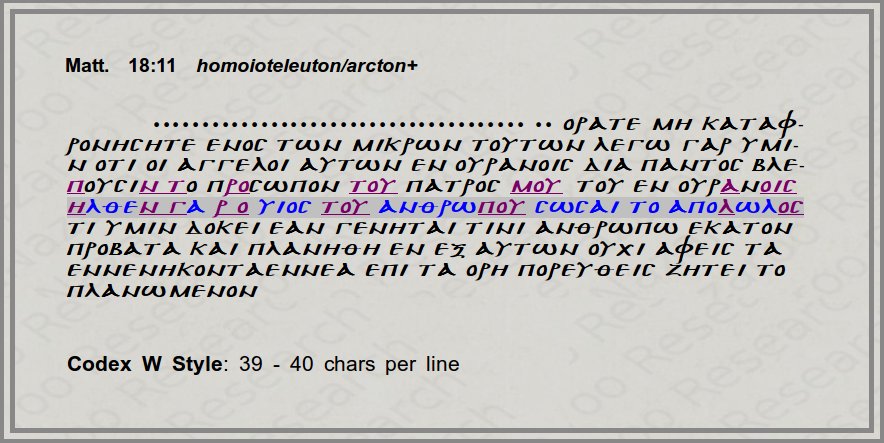
18:10 .................................................. ...ορατε μη κα-
ταφρονησητε ενος των μικρων τουτων λεγω γαρ υμ-
ιν οτι οι αγγελοι αυτων εν ουρανοις δια παντος βλεπ-
ουσιν το προσωπον του πατρος μου του εν ουρανοις
ηλθεν γαρ ο υιος του ανθρωπου σωσαι το απολωλος
τι υμιν δοκει εαν γενηται τινι ανθρωπω εκατον προβ-
ατα και πλανηθη εν εξ αυτων ουχι αφεις τα εννενηκ-
ονταεννεα επι τα ορη πορευθεις ζητει το πλανωμενον
Beware! -- do not
despise one of these little ones, for I say to you,
that their angels in the heavens do always behold
the face of my Father who is in the heavens;
for the Son of Man did come to save the lost.
`What think ye? if a scribe has a hundred verses,
and one of them there goes astray , does he not --
having left the copyist table, having gone into the
mountains -- then seek that which has gone astray?
Include verse 11: D K W X Δ Π 078 28 565 700 1071 1079 1230 1241 1242 1253 1344 1365 1646 2148 2174 Byz Maj (Majority of all Continuous MSS) Lect. l85pt it-a/aur/b/d/f/ff2/g1/l/n/q/r1 Vg Syr-C/p Arm Geo-1b Diatessaron Hilary(both variants) Chrysostom Augustine (with variations: ) (L-e/g/ 892-mg 1009 1010 1195 1216 l-[10 12 69 70 80 185pt 211 299 303 374 1642, l-950] it-c Syr-h Cop-bo(mss) eth.
Omit: א B L* f1 f13 33 892(txt) it-e/ff1 Syr-s/pal Cop-sa/bo geo-a Origen Apost. Can. Juvencus Euseb. Hilary(both variants) Jerome?
A second glance at the preceding line reveals a startling 14 out of 40 letters in the same order and similar position to the lost line, or 35% of the visual area for each line. almost 25% shared with the following line also helps to blur the position of the copyist.
Similar endings on three consecutive lines add to the fun, with someone in the Alexandrian stream dropping the ball early.
Naturally Hort and friends delete the verse, seeking the shortest possible text. Nobody told them the shortest text is simply none at all, and can be had anywhere.
The majority of modern translations delete the verse, which is I suppose some kind of 'majority reading'.
To paraphrase Metzger somewhat,
'The irony of the verse's content is overwhelming.'
Matt. 20:7 (traditional text)
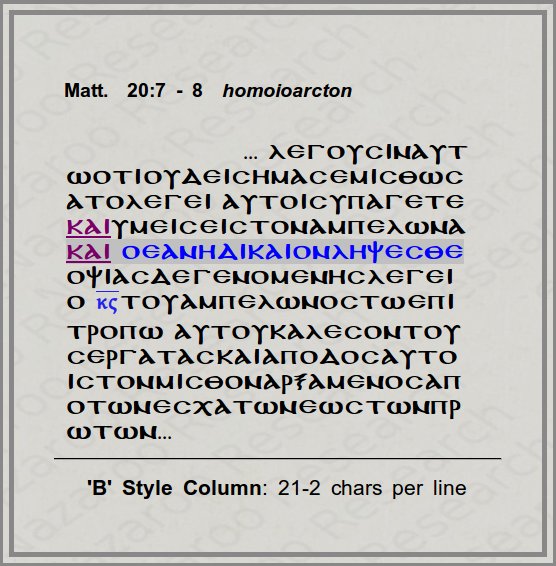
...λεγουσιν
αυτω οτι ουδεις ημας εμισθ-
ωσατο λεγει αυτοις υπαγετε
και υμεις εις τον αμπελωνα
και ο εαν η δικαιον ληψεσθε
"They *said to him,
`Because no one hired us.'
He *said to them, `You go
also into the vineyard.'
and you'll get whatever is fair.'
INCLUDE LINE: C*, W, Δ, f13, 22, 33, Maj, f, h, q, Sy-C, Sy-P, Sy-H, Sy-Palms Byz Maj (Majority of MSS),
add αμπε λωνα μου και... C(Corr3), N, 174, 346, 828(=f13-part), 565, 1241, pc
OMIT: א, B, (D), L, (Z),Θ, (085), f1, 892, Lat, (Sy-S), Co
αμπελωνα D, Z, 085, it, Sy-S, sa, mae-2 (+ εργαζεσθε ) NA has txt + mou for C(Corr3), but it reads Byz + mou as Swanson has it. K. Witte from Muenster confirmed this.
B: no umlautOnce again Haplography strikes the tired copyist. Similar beginning spells the end for a useful but unessential clause. We can understand this as an accidental loss much better than as any kind of "copyist's explanatory gloss".
There are hundreds of unique statements in Matthew that scream out for explanation, yet copyists resisted the temptation to expand for hundreds of years. There is no probability in any copyist or editor straining at a gnat and swallowing a camel here.
The features of 'homoioarchton' are classic here. Simliar beginning and just the right length for a fumble.
W. Willker says: "Probably a harmonization to verse 4. There is no reason for an omission." - but the blatant homoioarcton is right in front of us!
W/H follow Aleph/B, with Nestle and UBS-3 in tow. No footnote is found in UBS-2, and most modern versions give no warning that another half-verse has been lost via clumsy error by the ancestor of Aleph/B.
Matt. 20:16 (traditional text)
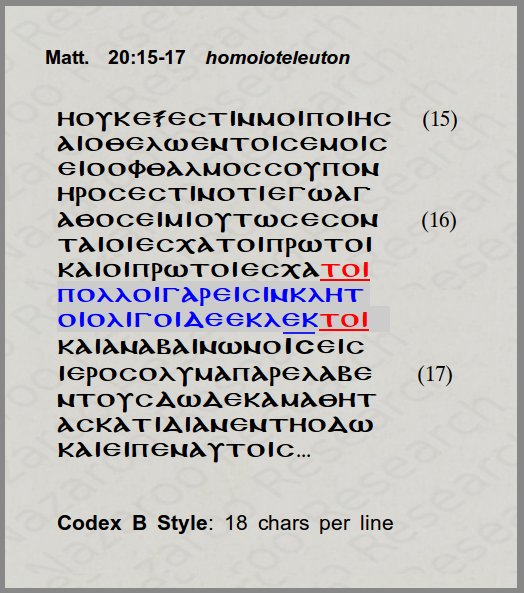
ουτως εσονται οι
εσχατοι πρωτοι και οι πρωτοι εσχατοι
πολλοι γαρ εισιν κλητοι ολιγοι δε εκλεκτοι
"..."So shall be the last first,
and of the first many last:
for many are called, but few chosen."
INCLUDE LINE: C, D, W, Δ Θ , f1, f13, 33, Byz Maj (Majority of MSS), Latt, Sy, mae-1, Bo(pt), [Trg]
OMIT: א B, L, Z, 085, 892*, 1342, 1424, 1675*, pc(14), sa, bopt, mae-2
pc = 4, 5, 36, 75*, 141, 278, 423*, 571, 797, 1093, 1243*, 1403, 1574, 2418*With ten different words ending in "οι" in a single compound sentence, its no wonder a tired copyist went cross-eyed here.
The original text is probably Mark 10:31, (cf. Luke 13:30) but Matthew is clearly aware of Luke's text, and probably has followed that, as he makes use of so much of Luke elsewhere. Luke 14:24 (Byz text) also has the longer version of the verse.
We must suspect some deliberate editing here, possibly confusion, once the omission occured. The problem with Matthew's (and Luke's) text, is that two distinct sayings have indeed been apparently conflated, probably in an effort at providing a context for them both. Are we really supposed to equate the "first and last" in the first saying with the "called and chosen" in the second?
Many may feel the second saying is far more ominous, perhaps even suggesting loss of salvation. But as Jesus originally spoke these words, they probably did not imply that few would be saved, and many lost. That would be a catastrophic failure of His mission to redeem Israel and open salvation to the Gentiles. More likely we have a legitimate connection between the two sayings, implying loss of status, not loss of salvation here.
In any case, the textual evidence is overwhelmingly in favour of an early accidental omission, complicated by some frantic editing/copying. Sticking with the traditional text is again the safest course.
W. Willker admits (Textual Commentary Matthew):
'This catchy saying has also been added after Lk 14:24.
Nevertheless it might be
an omission due to [homoioteleuton] TOI - TOI.
Note the corrected Byzantine minuscules!
This verse is the end of a lection. Possibly this caused the addition?'
- or omission...
Westcott/Hort omit the clause while following Aleph/B, and also other editors. No footnote or apparatus is provided in the UBS-text (2nd-4th ed.) and translators are wholly unaware that another important saying of Jesus has been snipped from the Gospels without even a hello.
Alternate possible exemplar layout:
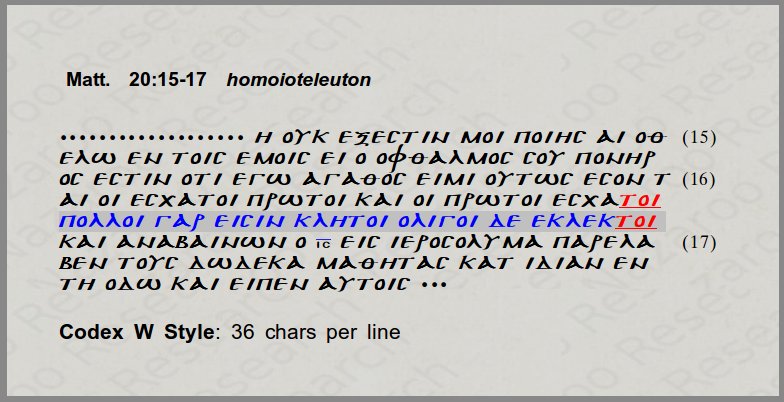
Matt. 20:22 (traditional text)
αποκριθεις δε ο ιησους ειπεν ουκ
οιδατε τι αιτεισθε δυνασθε πιειν
το ποτηριον ο εγω μελλω πινειν η
το βαπτισμα ο εγω βαπτιζομαι βαπτισθηναι
λεγουσιν αυτω δυναμεθα
και λεγει αυτοις, το μεν ποτηριον μου πιεσθε
και το βαπτισμα ο εγω βαπτιζομαι βαπτισθησεσθε
το δε καθισαι εκ δεξιων μου και εξ ευωνυμων μου
ουκ εστιν εμον δουναι αλλ οις
ητοιμασται υπο του πατρος μου
But Jesus answered, "You do not
know what you are asking. Are you able to drink
the cup that I am about to drink? - or
the baptism that I am baptized, to be baptized with ?"
They said to Him, "We are able."
and he saith unto them, of my cup Ye shall indeed drink,
and with the baptism that I am baptized with be baptized:
but to sit on my right hand, and on my left,
is not mine to give, but it shall be given to them
for whom it is prepared of my Father.
INCLUDE LINE: C, W, X, Δ Σ Φ f13, 33, 579, Byz, Maj (Majority of MSS), f, h, q, Sy-P, Sy-H, bo(pt) Lect
OMIT: א, B, D, L, Z, Θ, 085, f1, 788(f13), 22, pc, Lat, Sy-S, Sy-C, sa, mae-1+2, bo(pt)
B: no umlautThere is obviously plenty of opportunity for Haplography here, but we must strongly suspect some deliberate and unfortunate editing is really what occured.
A 3rd or 4th century Alexandrian editor probably looked at the first incredibly awkward clause, and jumped to the conclusion that it was in fact a marginal note of an alternate reading that had been inserted into the main text: That is, he read the "-or, ..." (20:22) as a textcritical comment by a previous copyist.
With this conclusion before him, he came to the second line, and took the "-and, ..." (20:23) as again a headsup for an alternate reading. Since the first half of each speech by Jesus makes plain sense, this editor adopted the first clause in each verse, and deleted the second clause as a secondary (incorrect alternate) reading. This editor's logic here is flawed however, since "and" is part of the reading itself, not a marginal note.
This novel solution to the plainly difficult and wordy text of Mark (as copied by Matthew) was attractive because it completely smooths out the awkwardness of the baptism references, including perhaps some sense of anachronism from their presence in Mark's original.
But the origin of these two clauses is not some imagined marginal gloss, but simply the text of Mark, which needs no explanation. It is Mark's usual clumsy translation/Semitic Greek, and its flavour has the usual (slightly anachronistic and back-viewing) features of a Markan speech of Jesus.
Another reason for rejecting the thinking and efforts of some Alexandrian editor here, is the second instance (20:23). This has the triple coincidence of homoioarcton (similar beginning), homoioteleuton (similar ending), and same length of clause (lucky alignment). From this we must strongly suspect that the original cause of the confusion and variation was indeed an accidental Haplography error in Matt. 20:23. This led to some Alexandrian editor examining the preceding verse and jumping to the idea that this was a case of alternate readings conflated from a marginal note.
Naturally this novel solution and the variant text created did not have the power to influence the entire transmission stream this late in the day (c. 2nd to early 3rd cent.), and it became a discontinued minority reading of the Alexandrian texttype.
Willker notes the lines originate from the parallel passage in Mark (Mk 10:38-39), and says; "Very probably copied from Mark (so Weiss). The support is not very good.".
But this is pointless. Matthew, even more than Luke, tends to copy Mark verbatum, even when its wordy or awkward, limiting himself to deleting unimportant details, not the speeches of Jesus.
Once we acknowledge that Matthew has here copied everything other single word verbatum from Mark, there is no strength nor need to claim this was some kind of later interpolation/harmonization with Mark by a copyist. The natural assumption is that Matthew simply copied Mark.
When Willker says "support is not very good", he has already rejected the traditional text (majority/Byz) used by Christians for centuries as "not very good". This bias permeates his entire commentary.
Westcott/Hort delete the verses, favouring again Aleph/B, and Nestle, UBS-2 follow. UBS says nothing in the apparatus, and so once again almost all the "modern versions" (English Translations) drop the verses without perhaps even knowing they have been hoodwinked again.
Another two clauses have been quietly deleted from the Bible without any documentation, notice, or justification.
Matt. 21:44 (traditional text) - homoioteleuton
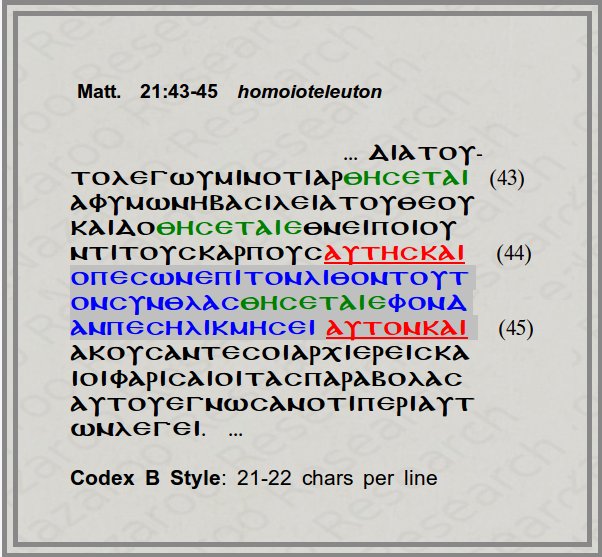
.............................δια τουτο λεγω υμιν οτι αρ-
θησεται αφ υμων η βασιλεια του θεου και δο-
θησεται εθνει ποιουντι τους καρπους αυτης και
ο πεσων επι τον λιθον τουτον συνθλασ-
θησεται εφ ον δ αν πεση λικμησει αυτον και
ακουσαντες οι αρχιερεις και οι φαρισαιοι τας
παραβολας αυτου εγνωσαν οτι περι αυτων λεγει...
......................................"From this I say to you that
the kingdom of God will be taken away from you and
given to a people, producing the fruit ofher and
he who falls on this stone will be broken to pieces;
but on whomever it falls, like dust it will scatter him: and
When the chief priests and the Pharisees heard His parables,
they understood that He was speaking about them.
Include Verse 44: א B ! C K L W X Δ Π (Θ 1079 1546) 0138 Family 1, Family 13, 28 565 700 892 1009 1010 1071 1195 1216 1230 1241 1242 1253 1344 1365 1646 2148 2174 Byz Maj (Majority of all Continuous MSS) Lect. it-aur/c/f/g1/h/l/q Vg Syr-C/p/h Copt-Sa/bo Arm Eth Geo Aphraates Ephraem Chrysostom Augustine Ps-Chrysos. etc.
Omit: D 33 it-b/d/e/ff1/ff2/r1 Syr-s Diat. Iren(Gk/Lat) Origen Euseb.
One can see the obvious trouble brewing as soon as the unfortunate alignment by chance occurs in some copy of the right line length.
And another line of Holy Scripture bites the dust, and vanishes, under the wandering eye of the aging copyist.
The failure to notice the obvious haplographic features are due in part to the poor choice of verse division introduced in the Middle Ages, which splits up the "KAI" and the preceding "AUTOS/HN", making the similarities appear to shrink by half!
But there is no real excuse for not studying the context of ANY serious omission in careful detail.
How can we believe that Hort didn't know this was a homoioteleuton error? It isn't even found in his beloved Aleph/B! Only the Latin Groaner-MS Bezae drops it! Yet Hort is compelled to bracket the verse. The credibility of the "brilliant" textual critic is now strained to the breaking-point, and his complicity cannot be hidden.
None the wiser for their previous folly, Nestle and UBS follow suit and bracket the offending verse. The Revised Standard (RSV) and New English Bible (NEB) leap to delete the verses, perhaps TOO enthusiastically for other more sensible translators like those behind the NAS and NIV.
Still another perfectly good verse is cast into doubt and disrepute, without cause.
Matt. 23:4 (traditional text)
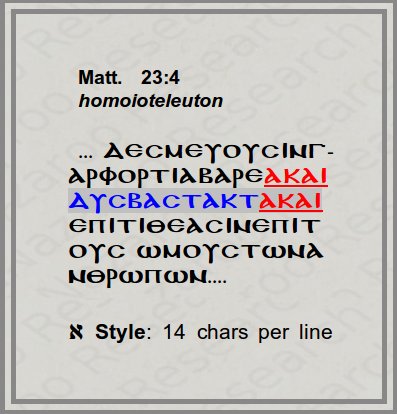
δεσμευουσιν
γαρ φορτια βαρεα
και δυσβαστακτα
και επιτιθεασιν
επι τους ωμους
των ανθρωπων
"For they bind heavy burdens
and grievous to be borne,
and lay them on men's shoulders;..."
INCLUDE LINE: B, D, K, P, W, Δ Θ, 0102, 0107, f13, 22, 33, 157, 579, Byz Maj (Majority of MSS), Lat(aur, c, d, f, ff1, g1, l, q, vg), Sy-H, sa, Weiss
652 (f1) does not omit here according to R. Champlin (Family Pi in Matthew, 1964, Studies and Documents 24). At least he is not mentioning it.
Lacuna: C
B: no umlaut
OMIT: - א, L, f1, 892, pc, it(a, b, e, ff2, h), Sy-S, Sy-C, Sy-P, bo, mae-2, Or, WH, NA25[!],This is another minor accidental drop by the Alexandrian ancestor of Aleph/B, caused by the clumsy construction using "KAI". Although a short skip, it is more evidence of just how common such errors are in this group of manuscripts.
This is not any kind of 'scribal gloss', but an original piece of 'translation-Greek' that has been eliminated, smoothing out the text.
Westcott/Hort insisted on following the omission (placing text in margin), even though Hort's favourite manuscript (B) includes the line. The Textual Critical "Canon", 'Prefer the Shorter Reading' overrode all other considerations, and even common sense.
Nestle and NA25 also follow omission. Again the lack of understanding regarding Agreement in Error, and its true significance in reconstructing the original text have resulted in modern critical Greek editions reintroducing obvious blunders.
The UBS-2 text at least gives a footnote here in the apparatus, giving modern translators a hint of the problem.
The American Standard Version (ASV) and Revised Standard Version (RSV) wisely left the phrase in the text, showing their awareness that this was a Haplography error, further modified by the interference of Caesarian editors.
Disappointingly, The New American Standard (NAS) and New International Version (NIV) take a step backward, and re-introduce the bumbling omission. Even the most ill-supported blunders manage to creep back into the text, in the quest for a 'lost' text.
Matt. 23:14 (traditional text) - homoioteleuton
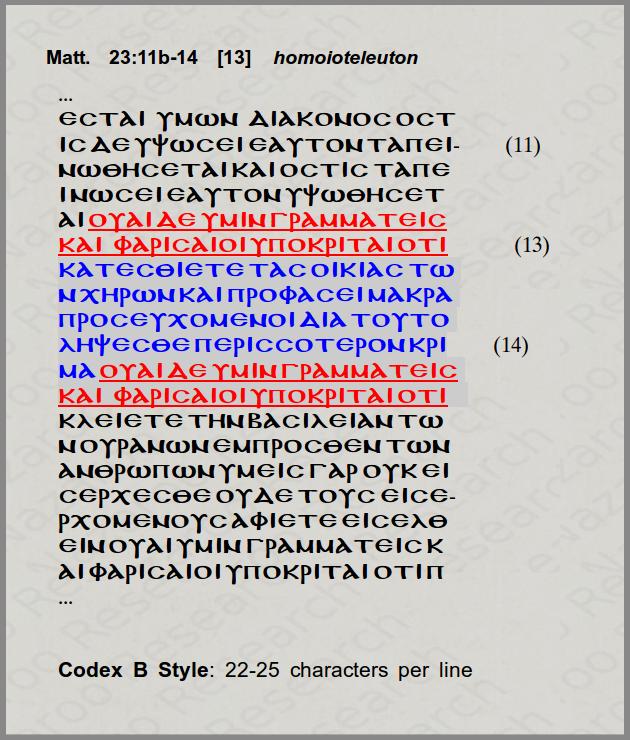
.........................................12..οστις δε υψωσει εαυτον ταπ-
......εινωθησεται και οστις ταπεινωσει εαυτον υψωθησεται
13..ουαι δε υμιν γραμματεις και φαρισαιοι υποκριται οτι κ
....ατεσθιετε τας οικιας των χηρων και προφασει μακρα π-
....ροσευχομενοι δια τουτο ληψεσθε περισσοτερον κριμα
14..ουαι δε υμιν γραμματεις και φαρισαιοι υποκριται οτι κ
......λειετε την βασιλειαν των ουρανων εμπροσθεν των αν-
......θρωπων υμεις γαρ ουκ εισερχεσθε ουδε τους εισερχο-
......μενους αφιετε εισελθειν
15..ουαι υμιν γραμματεις και φαρισαιοι υποκριται οτι περι-
.....αγετε την θαλασσαν και την ξηραν ποιησαι ενα προση-
.....λυτον και οταν γενηται ποιειτε αυτον υιον γεεννης διπ-
.....λοτερον υμων 16. ουαι υμιν οδηγοι τυφλοι οι λεγοντες
.....ος αν ομοση εν τω ναω ουδεν εστιν ος δ αν ομοση εν
.....τω χρυσω του ναου οφειλει. ...
Include verse 13: K W Δ Π 0107 0138 28 565 700 892 (1009) 1010 1071 1079 1195 1216 1230 1241 1242 (1253) 1365 1546 1646 2148 2174 Byz Maj (Majority of all continuous MSS) (l-76) it-f Syr-p/h Copt-Bo(mss) Eth. Chrysostom Ps. Chrysos. John-Damascus
Reverse verse 13/14: f13, l-547 it-b//e/ff2/h/l/r1 Vg-Cl Syr-c/Pal(mss) Copt-Bo(mss) Diat. Origen Hilary Chrysos.(some)
Omit: א B D L Θ f1 33 892(txt) 1344 it-a/sur/d/e/ff1/g1 Vg-ww Syr-pal(mss) Cop-sa/bo(mss) Arm Geo Origen(gr/lat) Euseb. Jerome Druthmarus
Matthew 23:14 is an interesting and elegant case of homoioteleuton, because it is not apparent what happened without examining the Byzantine Text and also understanding the real mechanics of what appears to be homoioARCTON.
The reason this instance has gone unrecognised is through not understanding both the actual mistake, and its deceptive result.
Pseudo-HomoioArcton (metamorphosis of similar beginnings)
In fact, most cases of "homoioArcton" (similar beginnings) are really homoioteleuton in disguise. The scribe's natural habit is to remember what he has just penned, and search for that in the master-copy. Thus a scribe does not usually hop from one similar beginning of a line to another, because he's not looking for the beginning of a line at all, but rather what he has just written, the end of a segment.
In pseudo-homoioarcton, a phrase at the beginning of a clause, sentence or verse actually falls at the end of a line, in some copy, due to the practice of filling up lines and even chopping up words to create more or less even margins on both sides. As a result, the scribe's eye treats the piece as though it were an 'ending' (i.e. copying right to the end of the line). He now looks back for a line ending he has written, but finds instead a similar "beginning" or really a line ending further down.
In the case above, the scribe most likely copied the first line of verse 13 correctly. Then, glancing back at his master-copy, he found the wrong line ending, namely the end of the first line of verse 14, and started copying this second verse from the point after that.
The result however, makes it appear that the scribe has skipped the whole verse 13 from beginning to end, because the beginnings are identical. Another copyist or editor, not fully understanding such subtleties, assumed that the whole verse was either added or deleted, and since the ENDINGS of the consecutive verses are NOT similar, homoioteleuton was not suspected.
To the amateur or inexperienced textual critic, this does not look like what it really is, namely homoioteleuton (similar endings). Instead it looks like a (rather unconvincing) case of homoioARCTON, which, since that rarely occurs as such, is dismissed as the cause of the variant.
The rest of the history of the variants is made plain by this. A corrector, noting the verse was missing, replaced it in the wrong place (not understanding the mechanism or where the real break was), and a new variant was created, with verse 13 and 14 reversed!
Again the original culprit is a sleepy-eyed Alexandrian scribe, with the Italians replacing the verse at the wrong spot.
The Hortians, and UBS adopt the worst possible variant (omision) as if it were the original text, and all the 'modern' versions follow, psychologically disturbed by the displacement of the verse in some copies.
However, such apparent "positional uncertainties" have nothing to do with the certainty and authenticity of the text. They are mechanical features caused by the nature of the accidents in copying only.
The entire set of variants could really only have come about one way, with reasonable assumptions about copying habits.
Matt. 26:3 (traditional text)

...τοτε συνηχθη-
σαν οι αρχιερεις
και οι γραμματεις
και οι πρεσβυτεροι
του λαου
Then gathered
the chief priests,
and the scribes,
and the elders
of the people,...INCLUDE LINE: K, Δ Π, 0255, 22, Byz Maj (Majority of MSS), it(c, f, ff2, h, q, r1), Sy-P, Sy-H
(+ kai oi pharisaioi) W
OMIT: P45, א, A, B, D, L, Θ, 0293, f1, 652, f13, 33vid, 565, 700, 892, 1424, pc, txt Lat(a, aur, b, d, ff1, g1, l, vg), Sy-S, Co(+ mae-2)
Lacuna: C, Sy-C
B: no umlautAnother very ancient but easy case of Haplography, all the more obvious given the text of the majority of MSS, and independant manuscript support.
In the past, the heavy editing that occured with the 3rd and 4th century uncials has been ignored or denied. But the flip-flop testimony among them when taking these Haplography cases together as a group shows just how much monkey-business indeed happened. If we were to accept the current position that the old uncials best represent the state of the text in the 4th century, then we'd have to admit that the state of the text was incredibly sloppy and wild.
But there is a reasonable alternative: that the state of the text for most manuscripts was stable and reliable, and those manuscripts were copied, worn out, and recycled, while the 'survivors' represent instead some of the worst excesses in text manipulation, and were eventually abandoned.
We have no reason not to believe that when the text was standardized in the following centuries, that Christians throughout the Roman world independantly held fast to the best copies, and adopted the most accurate texts they had. If so, then the majority of copies will represent the best overall text, most of the time.
This is another case where Hort, Nestle, & UBS uncritically adopt the Aleph/B text, even when haplography best explains the MS variants. The UBS text offers no documentation in its critical apparatus.
Naturally, 'modern' versions following UBS drop the text without a footnote, reviving a clumsy error that had been previously corrected and forgotten.
Matt. 27:35 (traditional text)
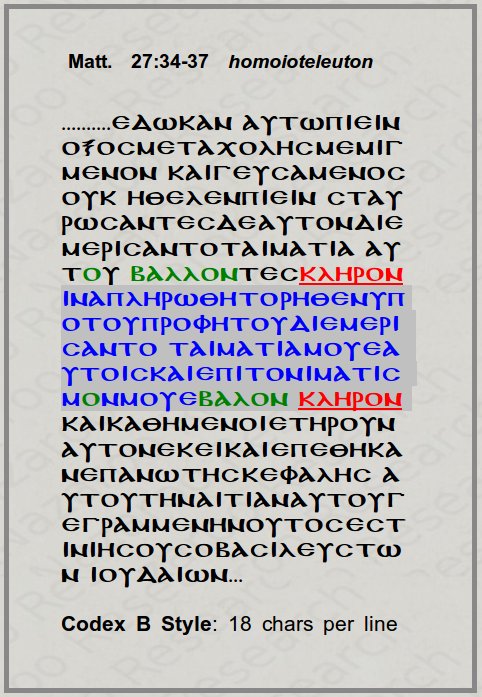
σταυρωσαντες δε αυτον διεμερισαντο
τα ιματια αυτου βαλλοντες κληρον
ινα πληρωθη το ρηθεν υπο
του προφητου διεμερισαντο
τα ιματια μου εαυτοις και επι
τον ιματισμον μου εβαλον κληρον
And they crucified him, and parted
his garments, casting lots:
that it might be fulfilled which was spoken by
the prophet, 'They parted my garments among them, and upon
my garment did they cast lots.'
INCLUDE LINE: Δ Θ Φ 0250, f1, 652, f13, 22, 517, 954, 1071, 1243, 1424, 1675, al, it(a, aur, b, c, h, q), vg(part), Sy-H, mae-1 (not mae-2), Eusebius (add after verse 36:) 983
Lacuna: C, Sy-C
OMIT:א, f13(2 mss: 174, 828 no addition) ;
it: d, f, ff1, ff2, g1, l, vg(part) do not have the addition, NA27 omits from text. B marks omission with umlaut: (line 16 B, p. 1275)βαλλοντες κληρον, (36) και καθημενοι..Because of lack of some major Byzantine support, even proponents of that text don't attempt to defend this longer reading vigorously. But the abandonment of this longer version of the verse is in fact premature.
Willker says:
'It is possible that the sentence fell out due to homoioteleuton (...κληρον - ...κληρον) but the support is bad (basically "Caesarean"). It is more probable that it has been added from the Johannine parallel (so Weiss). Rating:2? (omission probably original)'
Byzantine Text-type Never Guilty of Omission?
The first remark that needs to be made, is that if the Byzantine text-type can be guilty of "addition/conflation" everytime it has a fuller reading (according to these same textual critics), why can't it also occasionally lose some text? It can't be infallible in this regard. That alone is enough to hold the question open.
Caesarean Text-type Cannot support Haplography?
The next remark is that why is the Caesarean text-type suddenly "bad"? The majority of the omissions which modern critical NTs adopt have mainly Caesarean/Alexandrian support, not Byzantine. Here the Caesarean text finds the Byzantine guilty of haplography, and its somehow inconvenient.
That Haplography historically occured is admitted to be a fact. Examples of 1st generation haplography errors abound in all manuscripts. Why is it that actual confirmed examples are practically non-existant in modern critical NT texts? Are we to believe that not a single case of haplography was ever copied, and found its way into a text-type or group?
And why is it that approximately a third or more of possible cases have been completely left out of the critical apparatus? Could it be that they would negatively characterise a favoured text-type?
Could an extremist application of 'Prefer the Shorter Reading' be behind this inconsistent behaviour? The original justification for that rule of thumb was supposed to be based on scribal habits. In real life there must always exceptions to rules based on rough generalizations.
How Many Haplographic Features are Enough?
Willker is too honest to leave out the possibility of homoioteleuton (...κληρον - ...κληρον): But he has certainly downplayed the evidence. In actual fact, the two clauses share 19 out of 27 letters in the precise same order (70%!), in 5 - 6 character-length chunks! This is an order of magnitude stronger than a typical case of 3 or 4 letters at the end of a sentence.
Relative Priority of Matthew at Stake
When Matthew copies Mark, even Roman Catholic scholars are willing to accept the possibility of Markan Priority. This does not directly threaten Matthew's authority. But Matthew is always assumed to have priority over John, and to be roughly contemporary with Luke. John is written off as 'late' mainly on internal considerations and on the basis of the supposed "evolution" of Christian theology.
But what if Matthew wrote after John? Many synoptic/Johannine features would be better explained if that were the case, but unfortunately, the cost would be too high for some Roman Catholic groups, who find most scriptural support for 'church authority' in Matthew (Matthew is the only gospel that even mentions the word "church", and obvious clue to its later date).
This may be another reason why cases like this, in which Matthew seems to know John's content are better treated as "later additions to Matthew" rather than cases where Matthew used John.
Its no real surprise then, that Roman Catholic sponsored, and ecumenical 'modern' versions of the NT favour the exclusion of verses like this, and also favour Roman Catholic ecclesiastical manuscripts like Codex Vaticanus (B, Vatican #1209).
This is a shame, for such bias interferes with a real understanding of the historical process of transmission, and the identification of the original text.
Cases of
Haplography in John
John 3:13 (traditional text)
...και ουδεις
αναβεβηκεν εις τον
ουρανον ει μη ο εκ
του ουρανου καταβας
ο υιος του ανθρωπου
ο ων εν τω ουρανω
"...And no one has ascended
up to heaven, if not the One
coming down out of heaven,
the Son of Man;
the One in heaven."
INCLUDE LINE: A/A(corr), K Δ Θ Π ψ 050 (063) f1 f13, 28 565 700 892 1009 1071 1079 1195 1216 1230 1242 1253 1344 1365 1546 1646 2148 2174 Byz, Maj (Majority of all continuous MSS), Lect, l -184 211 (s,m),883 1579 (m), it-a/aur/b/c/f/ff2/j/l/q/r1, vg, Syr-P/H/Pal?, Cop-Bo(mss), Arm Geo, Diatess., Hippolytus Novatian, Origen-Lat, Dionysius Eustathius Jacob-Nisibus Aphraates Hilary Lucifer Basil Amphilochius Didymus Epiphanius Chrysostom Nonnus Cyril Theodoret (0141, 80, Syr-S)
OMIT: P-66/75 א, B L W-supp, 083 086 0113 33 1010 1241 Cop-Sa/Bo(mss)/Ach2/fay, Aeth, Diattess.-(arm)/v, Origen-Lat.mss, Apollinaris, (Didymus, Cyril)
Here is a case where giving credence to an omission which is in fact a Haplography error becomes ludicrous: Virtually every early father and writer that can be checked cites the full verse. Two fathers appear influenced by Caesarean editors in a couple of copies. Thus as well as overwhelming manuscript support, we have overwhelming patristic support in favour of including the line as original, to say nothing of the obvious 'internal' criteria, the physical requirements for homoioarchton (accidental omission from similar beginning of line/phrase).
As expected, Westcott/Hort follow Aleph/B, Nestle and UBS follow Hort, and half the 'modern' translations follow UBS. The comedy of errors forms a long chain of unbroken dumbness. Surprisingly, the American Standard Version (ASV) and New English Bible (NEB) manage to drag their heads out of the sand long enough to avoid this re-introduction of an ancient error. P66/75 show the blunder to be very ancient, but once again generated by the usual suspects, clumsy Alexandrian editors interfering with the text.
Although once the line was lost in some copies, it is possible to see a theological motive for leaving it out (among Arians, or those who deny the pre-existance doctrine of Christ), but why look for conspiracies, when stupid explains so much? Occam's Razor can be sensibly applied here.
Look in vain for sensible or enlightening footnotes in modern versions.
4th Century Editing
Of course the initial booboo doesn't fully explain the course of its repetition. F.H.A. Scrivener is most enlightening on the subsequent history of this obvious blunder:
19. John 3:13 Westcott & Hort remove from the text to the margin the weighty and doubtless difficult, but on that account only the more certainly genuine, words ο ων εν τω ουρανω. Tischendorf rejected them (as indeed does Prof. Milligan) in his Synopsis Evangelica (1864), but afterwards repented of his decision.
The authorities for omission are א, B L (which read [also] read μονογενης θεος ['onlyborn god'] in Jn 1:18), Tb [6th cent.], MS 33 among the MSS. CDF are defective here: buth the clause is contained in AEGHKMSUVΓΔΛΠ, and in all cursives save one, A* and one Evalngelistarium (44) omitting .
No versions [translations] can be cited against the clause except one MS of the Bohairic: it appears in everyone else, including the the Latin, the four Syriac, the Ethiopic, Georgian and the Armenian.
There is really no Patristic evidence to set up against it, for it amounts to nothing that the words are not found in the Armenian versions of Ephraem's Exposition of Tatian's Harmony (see Vol. I p.59 note 2); that Eusebius might have cited them twice but did not; that Cyril of Alexandria, who alleges them once, passed over them once; that Origen also (in the Latin xlat.) neglected them once, inasmuch as he quotes them twice [!], once very expressly. Hippolytus [220 A.D.] is the prime witness in their behalf, for he draws the theological inference from the passage (αποσταλεις ινα δειξη αυτον επι γης οντα ειναι και εν ουρανω), wherein he is followed in two places by Hilary and by Epiphanius. To these add Dionysius of Alexandria [3rd cent.], Novatian [3rd], Aphraates the Persian, Didymus [4th], Lucifer, Athanasius, Basil, Ambrose, Jerome, Augustine, John of Damascus (3x), Cyril of Alex., Chrystostom & Theodoret (4x each);
- Indeed as Dean John Burgon has shown, 1 more than 50 passages from 38 ecclesiastical writers; and we then have a consensus of versions and writers from every part of the Christian world, joining Codex A and the later MSS in convicting א, B L &c., or the common sources from which they were derived, of the deliberate suppression of one of the most mysterious, yet one of the most glorious, glimpses afforded to us in Scripture of the nature of the Saviour, on the side of His proper Divinity."
1. The Revision Revised, p. 133. Also Miller's Textual Guide, App. VI.
-F.H.A. Scrivener, Plain Introduction,
(4th Ed.,1889 Ed. Miller) Vol. 2, Ch 12: Examples pg 360 fwd
John 5:16 (traditional text)
και δια τουτο εδιωκον τον IN [οι ιουδαιοι]
και εζητουν αυτον αποκτειναι
οτι ταυτα εποιει εν σαββατω
and because of this they persecuted Jesus
and sought Him to murder (Him),
since these He did in the Sabbath...
INCLUDE LINE: A, N, X, Δ Θ ψ, f13, 213, 865, 1071, Byz, Maj (Majority of all continuous MSS),Latin: - e, f, q, r1, 27, Sy-P, Sy-H, Bohairic etc. Lect,
OMIT: P-66/75 א, B, C, D, L, W, 0141, f1, 69, 33, 397, 565, 579, 597, 821, 892, 1010, 1241, 2718, 2786, pc20, Lat(a, aur, b, c, d, ff2, l, vg), Sy-S, Sy-C, sa, bopt
Here one can imagine a typical 3rd-4th century manuscript, with its contractions of Sacred Names and common words, such as Jesus, Christ, God, Jews, etc., allowing for shorter lines and compacted Uncial (capital) letters.
The result is another opportunity ripe for a Haplography error, and sure enough a clause was dropped at some point. That the Jews were seeking to kill Jesus is quite plausible, given the reason for the anger: public defiance of the Sabbath, in the very Temple of Jerusalem. And we need not limit this to the religious authorities, as Paul's experience in Acts demonstrates.
Not something a Jewish scribe would easily invent, but quite natural to leave omitted, for the purpose of toning down blanket accusations and racial hostilities.
The split among the Syriac versions shows both readings to be as old as the 2nd century.
The UBS text doesn't even note the variant. It becomes yet another completely undocumented alteration of the Traditional text, almost unanimously adopted by 'modern' versions simply because they follow UBS or Nestle/Aland by habit.
John 6:11 (traditional text)
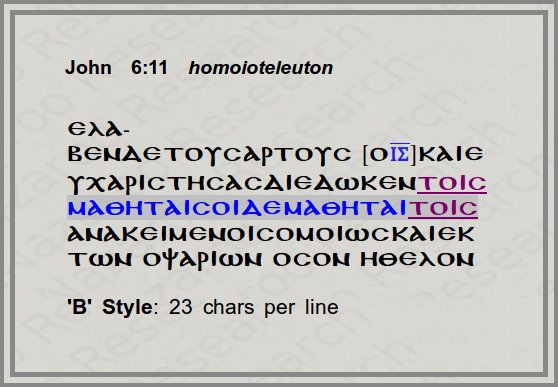
ελαβεν δε τους αρτους ο IΣ [Jesus]
και ευχαριστησας διεδωκεν
τοις μαθηταις οι δε μαθηται
τοις ανακειμενοις ομοιως
και εκ των οψαριων οσον
ηθελον...
And Jesus took the loaves;
and when he had given thanks, he gave
to the disciples, and the disciples
to them that were set down;
and likewise of the fishes as much
as they wished.
INCLUDE LINE: א(Corr.2), D, Δ Θ ψ, f13, 1071, Maj, Latin: b, d, e, j, Sy-S, ac2, Bo(mss) Byz, Maj (Majority of all continuous MSS), 157, 1424 Lect,
OMIT: P28(3rd CE), P66, P75, 01*, A, B, L, N, W, Π, 063, 0141, f1, 33, 565, 579, 1241, al, Lat, Sy-C, Sy-P, Sy-H/sa/bo(mss), arm, goth
Another classic boo-boo by the Alexandrian ancestor of Aleph/B. This one of many 'perfect' Haplography cases in John, where all the necessary features are found in the textual stream.
Few Alexandrian correctors would have opted for the longer reading, given the lucky conciseness of the omission. But no complex series of 'mishaps' are likely to have been responsible for any proposed 'addition' here. Again the theological content is virtually non-existant.
The usual suspects, Westcott/Hort, Nestle, UBS-2 etc. perpetuate an error we escaped from for almost 2000 years. Now every scribal blunder ever made is brought back to haunt the text, simply because it was done in Egypt/Caesarea. Again, 'modern' versions follow the UBS text, without even a footnote for the lost half-verse.
Its another undocumented change, which sadly loses some interesting details concerning the Feeding of the 5,000.
John 6:22 (traditional text) -homoioteleuton
.......................................................τη επαυρ-
ιον ο οχλος ο εστηκως περαν της θαλασσης
ιδων οτι πλοιαριον αλλο ουκ ην εκει ει μη εν
εκεινο εις . ο ενεβησαν . οι. μαθηται. αυτου
και οτι ου συνεισηλθεν τοις μαθηταις αυτου
ο ιησους εις το πλοιαριον αλλα μονοι οι μαθ-
ηται αυτου απηλθον
The day following, when the people which stood
on the other side of the sea saw that there was
none other boat there, if not that one where in
those were entered, namely, His disciples,
and that Jesus went not with His disciples
into the boat, but that his disciples were
gone away alone;
Include Line: : א* (D Grk*), (D corr) Θ 28 (33 1071 ((1195 1253)) 1216 1230) 700 892 1242 1344 1646 (2148 2174) Byz Maj (Majority of MSS) f13 (it-a/c/d) Syr-c/(p)/h/pal Copt-sa Arm Geo-l/A/(B) (Chrysostom Cyril)
Omit: P75 א(corr.) A B L W Ψ 063 f1 565 1009 1010 1079 1241 1365 1546 it-aur/(b)/c/f/ff2/l/q/(r1) vg cop-bo/ach2/fay goth Nonnus
Mistakes like starting on the wrong line at left when it is a long one are so commonplace and trivial that this hardly needs comment. Its familiar to anyone who has read a book and started again on the wrong line in the middle of a paragraph.
There is no need for yet another elaborate theory of an imaginary editor who could invent a long-winded, awkward turn of phrase to bloat the narrative for no purpose except perchance to fill out a line at the end of page. Thats what dashes, dots and scribbles are for.
Why yet again did such an (imaginary) expositor pass up the chance to add a theological text of some significance?
Yet Hort denies the obvious, and entrenches this early error into the "Neutral" Text-type (Hort's pure and original invention).
The UBS edition follows Hort, with countless 'modern' versions in tow, stuffed with useless or nonexistant footnotes, but lacking a full text.
John 8:59-9:2 (traditional text)
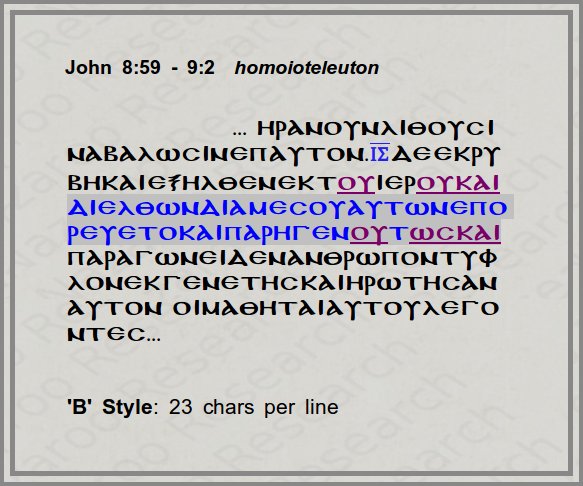
...ηραν ουν λιθους
ινα βαλωσιν επ αυτον. IΣ δε εκρυβη και εξηλθεν εκ του ιερου
και διελθων δια μεσου αυτων [επορευετο] και παρηγεν ουτως
και παραγων ειδεν ανθρωπον τυφλον εκ γενετης
και ηρωτησαν αυτον οι μαθηται αυτου λεγοντες ...... Then they took stones to cast
upon Him: but Jesus hid Himself, and went out of the Temple,
and going through the midst of them, and so he passed by;
and as He passed by, he saw a man who was born blind;
and His disciples asked Him, saying...
INCLUDE LINE: א(Corr.1), C, L, N, X,ψ, 070, 0141, 0211, 33, 213, 397, 579, 597, 799, 821, 865, 892, 1010, 1071, 1241, 2786, pc19, Sy-P, Sy-H, Sy-Pal, bo, geo2
(omit "και"/"επορευετο"): A, K, Π Δ Θ(Corr), f1, f13, 157, Lat: f/q, goth
Byz, Maj (Majority of all continuous MSS) Lect,
OMIT LINE: P66/75, א*, B, D, W, Θ*, 849, pc9, Lat, Sy-S, sa, ac2, arm, geo1
B: no umlaut
A comedy of errors seems to conspire to obscure what plainly happened here. First of all, the separation of John into chapters is very recent (c. 1500 A.D.), but the following lines clearly continue a narrative, and were normally written tightly together in ancient times.
Ironically, we must ignore the Byzantine text temporarily to put the puzzle back together.
Instead we turn to the oldest Uncial, Codex Sinaiticus for the missing pieces. Here Copyist A carefully preserves the original text, dropped by either א* or his exemplar. But Copyist A (circa 320 A.D.) discloses that the line originally had και immediately following the word 'Temple'. This was the και which caused the copyist of Codex Sinaiticus' ancestor to skip the line.
In the 2nd-3rd centuries, when copies were made on papyrus, pages had wide single columns, not groups of 3-4 narrow columns as found in Aleph/B. It must have been at this time that the omission happened.
The new format of the Uncials made on parchment (with shorter lines) made the Haplography error harder to spot, allowing it to slip under the radar in Codex Vaticanus and other MSS.
It did not help matters when the Byzantines, through independant lines of transmission deleted the "AND" (και), and so removed yet more evidence of the haplography error.
Finally, the UBS-2 apparatus, including the redundant word preceding the omission in every variant, makes the Haplography (homoioarchon) virtually invisible, even in the apparatus. Dividing up the witnesses that include the line, over minor variations, further obscures and confuses what happened.
The usual suspects, Westcott/Hort, Nestle, UBS-2 etc. perpetuate an error we escaped from for almost 2000 years. Again, 'modern' versions follow the UBS text, without even a footnote for the lost half-verse.
Its another undocumented change, which sadly loses one of the key components of the whole Chiastic Structure of this section. The fuller text shows Jesus exiting the Temple in the same supernatural way He arrived, and this compositional key is obliterated by the boo-boo.
John 10:12-13 (traditional text)
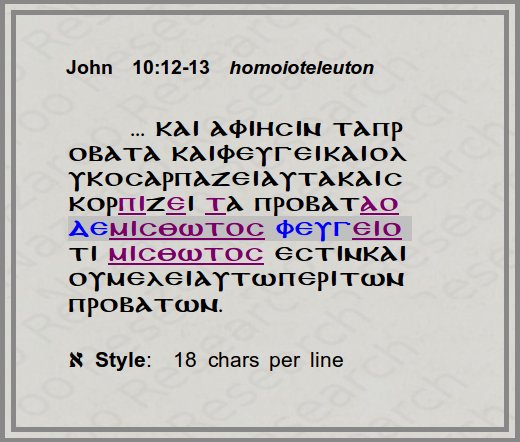
ο μισθωτος δε και ουκ
ων ποιμην ου ουκ εισιν
τα προβατα ιδια θεωρει
τον λυκον ερχομενον
και αφιησιν τα προ-
βατα και φευγει και ο
λυκος αρπαζει αυτα και
σκορπιζει τα προβατα
ο'δε μισθωτος φευγει
οτι μισθωτος εστιν και
ου μελει αυτω περι των
προβατων.
"But the hireling, and not
the shepherd, whose sheep
are not his own, sees the
wolf coming,
and abandons the sheep,
and he flees; and the
wolf captures these, and
and scatters the sheep.
But the hireling will flee,
since he is a hireling, and
does not care about the
sheep."
INCLUDE LINE: A(corr), X, Δ ψ, 0141, f13, 22(marg), 157, 565, 700, 1071, 1424,
Byz, Maj (Majority of all continuous MSS)
Lat, Sy-P, Sy-H, goth, [Trgmg]
OMIT LINE: P45, P66, P75, א, A*, B, D, L, W, Θ, 0211, f1, 22*, 33, 579, 1241, al, L253, d, e, Sy-S, Sy-Pal, Co, aeth, arm
W: further omits οτι μισθωτος εστιν, C: lacuna, B: no umlaut
All 3 main Greek Critical Texts Omit the text: (WH, N, UBS2)
All Modern versions RETAIN THE TEXT (ASV NAS NIV RSV NEB NBV etc.).
Here is perhaps a wonderful example, because not only is the External Evidence (textual features) overwhelming in favour of a simple Haplography error, but the Internal Evidence is also overwhelming in favour of the fuller text.
In fact, the evidence is so strong for an accidental omission, that not a single 'modern' version has dared to omit the line! It seems that dozens of committees of editors and Bible critics had to confess over and over again that dropping the line made the whole parable/analogy absurd.
Why? Because then the last half of the verse, which talks of the Wolf, runs straight into " - because he is a hireling", making the Hireling and the Wolf the very same person, and making the story of the hireling fleeing from the wolf nonsensical and ridiculous.
Believe it or not, Westcott/Hort adopted the omission, insisting on mechanically following the textual evidence no matter how foolish, in search of the ever-retreating mirage of the 'Neutral Text'. Nestle, and UBS-2 blindly follow, believing (perhaps rightly) that this 'agreement in error' proves an earlier ancestor for Aleph/B.
Yet by the 1950s, thank God, somebody began to strongly suspect that this 'ancient ancestor' of Aleph/B was not the original text after all, but an all-too-human copy of the Gospels no better executed or preserved than any other manuscript, version, or ancient quotation of the text.
But what to do? Instead of taking a long hard second look at the dozens of omissions of whole and half-verses, of phrases and clauses, they had been busy deleting from the Holy Bible, the editors did what we can expect all cowards to do: Say nothing, and quietly ignore the "assured results" of Textual Criticism in this case, and hope that nobody noticed the embarrassing gaffe utterly entrenched in the Alexandrian Text.
Note that even the normally slavish Codex W simply couldn't stand the Alexandrian text as he found it, and decided to solve the problem his own way, by again deleting yet another half-line, to cover the awkward connection where the text came together after the first boo-boo.
But what should the editors of 'modern' versions have learned from this embarrassing episode? They should have recognised the dubious quality of these 'ancient' witnesses, and downgraded their authority. They should have learned to put more trust in the thousands of early Christians who wisely abandoned such poor copies of Holy Scripture in favour of better ones, and who independantly preserved the Traditional Text for us.
John 11:41 (traditional text)
...ηραν ουν τον λιθον
ου ην ο τεθνηκως κειμενος
ο δε IΣ ηρεν τους οφθαλμους
ανω και ειπεν πατερ ευχαρισ-
τω σοι οτι ηκουσας μου
...then they took away the stone
from where the dead was laid;
But Jesus lifted His eyes
up and said, "Father I thank
You since You have heard Me..."
INCLUDE LINE: C(corr.3), Δ, 0141, f13, 700, 892S, 1424, Byz Maj (Majority of all continuous MSS)
OMIT LINE: P66, א, B, C*, (D), L, W, X, Θ ψ, 0233, 33, 157, 1241, pc, Lat, Sy, sa, ac2, arm
Once more, the reading is completely missing from the UBS-2 apparatus, and Nestle/Aland don't give adequate documentation either in their footnotes: They simply list the Traditional reading as "Byz" (=Byzantine). W. Willker has supplied at least some witnesses.
Many MSS are simply lacking the pages (e.g. P59/P75 ), but there is early Uncial support for the line, making both readings very old. The strongest clues to what happened are the double-Haplography features: similar beginning AND ending of lines, as well as similar letters in mid-line.
As with other examples, the wild variation in support between these potential cases of Haplography clearly indicate that these omissions come from different and independant sources: that is, many of them must be in fact errors, and not 'lucky preservations' of the original text.
We should not be surprised to find a rich supply of cases which suggest one of the most common errors, Haplography. The only more frequent mistakes will be spelling errors and word-order reversals, when a scribe skips a word and stuffs it in immediately afterward to avoid having to erase.
In this case, all the 'modern' versions drop the line without notes, snipping off yet another bit of text, and reviving one more ancient gaffe.
John 13:31-32 (traditional text)
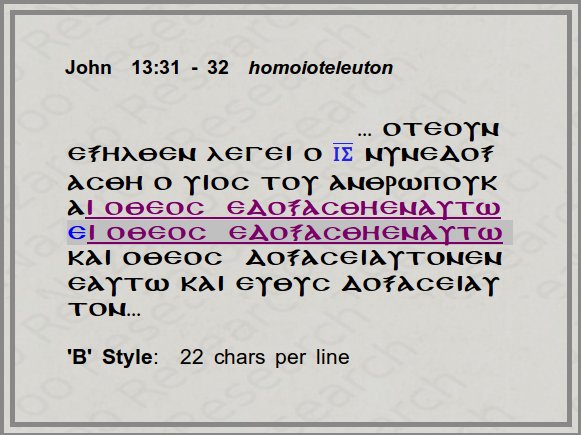
οτε ουν εξηλθεν λεγει ο IΣ νυν
εδοξασθη ο υιος του ανθρωπου
και ο θεος εδοξασθη εν αυτω
ει ο θεος εδοξασθη εν αυτω
και ο θεος δοξασει αυτον εν
εαυτω και ευθυς δοξασει αυτον
Then as He left, Jesus said, "Now
is glorified the Son of Man,
and God is glorified in Him:
if God is glorified in Him,
God also will glorify Him in
Himself, and glorify Him immediately!"
INCLUDE LINE: א(Corr.2), A, C(Corr.), K, Δ Θ ψ, f13, 33, 157, 565, 700, 1241, 1424, Maj (Majority of all continuous MSS) Lat(aur(C), e, f, ff2(C), q, r1, vg), Sy-P, sa, bo(pt), goth, Or(Lem), Nestle/Aland-25th ed.
OMIT LINE: P66, א*, B, C*, D, L, W, X, Π*, f1, 2*, 579, 1071, al, L253, it(a, aur*, b, c, d, ff2*, l, 11A, 29, 47), vg(mss), Sy-S, Sy-H, ac2, mf, bo(pt), Westcott/Hort (1882)
Westcott/Hort follow their favoured manuscripts, Codex Vaticanus/Sinaiticus (B/Aleph). The UBS text places the line in single brackets, because it can't bring itself to firmly commit to the obvious Haplography, due to the ongoing (and increasingly embarrassing) deference for the early Alexandrian witnesses, chiefly Aleph/B.
But here even Nestle balked, and left the traditional text alone.
The only 'modern' version to follow Westcott/Hort here is the old American Standard Version of 1901. Virtually every New Testament scholar since Hort (1882) has long since abandoned defending this absurd omission by the old Uncials, and no modern translation has been willing to adopt the cut.
Even the support of Papyrus 66 (P66) gives no confidence in this boner, in which the original two lines differ by only a single letter! But the error was old, and copied by those using the Alexandrian manuscripts as their master-copies. Thankfully, independant and uncontrolled copying prevailed, preserving the line in the majority of MSS.
Its not that this omission is catastrophic to the passage, which retains reasonable sense without it. But no scribe/editor would insert an unneeded complex conditional clause (an "If...then" statement) into a flat monologue, especially when it adds absolutely nothing to the message.
The lesson is plain however: the Alexandrians were indeed prone to dropping lines and failing to correct them, allowing many such worthless variants to sneak into the copying stream. And it really is a worthless variant, when it adds nothing to the text either way.
-->
John 17:12 (traditional text)
οτε ημην μετ αυτων
εν τω κοσμω
εγω ετηρουν
αυτους εν τω
ονοματι σου
"While I was with them
in the world,
I was keeping
them in your name [Father]..."
INCLUDE LINE: A, CC3, DC, X, D, Δ Θ ψ 0141, f13, 33, 157, 579, Maj, f, q, Sy, arm, goth
Byz, Maj (Majority of all continuous MSS)
OMIT LINE: P60(7th CE), P66, א, B, C*, D*, L, W, f1, 1071, pc, Lat, Co, Did
Another minor, but significant case of Haplography (homoioarcton - similar beginnings).
Its just a small stutter in the copying stream, but no argument can be made that anyone could even have conceived of adding "in the world" to this sentence, for any reason. The content of the phrase is so self-evident that no one could imagine needing to spell it out.
Only the original author (John the Evangelist), who is instead simply keeping a record of an actual speech, would have included this. You don't tug on superman's cape, and you don't needlessly shorten a speech from Jesus.
By now we've come to expect Aleph/B's ancestor to drop lines from time to time.
Why do all 'modern' versions leave out the text? Because the UBS-2 Greek text (following Westcott/Hort) has dropped the phrase, without any footnote at all. Most of the English translators were probably unaware of yet another undocumented and unwarranted alteration of the traditional text.
John 19:16-17 (traditional text)
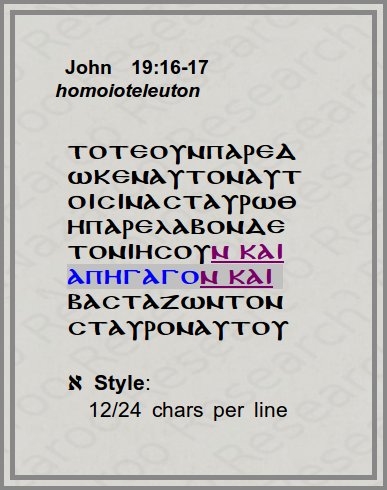
τοτε ουν παρεδωκεν
αυτον αυτοις ινα
σταυρωθη παρελαβον
δε τον ιησουν
και απηγαγον
και βασταζων
τον σταυρον αυτου
So then [Pilate] Handed him
over to them in order to
be crucified. And they
took along Jesus
and led him off,
and carrying
his cross, ...
INCLUDE LINE: D(S), K, P, D, Q, 157, 1071, 1241,
Byz, Maj (Majority of all continuous MSS)
(KAI) A, N, W, 0290, f1, 565, 579 al
(+ auton) - א,
(+ eis to praitwriaon) - M?, U, G, 700, al, Lect(mss), Sy-Pal(mg)
(+ kai epethhkan autw ton stauron) - f13, L844, Or(Lat) (118)
OMIT LINE: B, L, X, ψ, 0141, 33, pc, it(a, aur, b, c, e, ff2, r1), bo
It matters not whether the eye slipped across a long line or down a short one in a Haplography accident, and we can expect a fair share of short skips as well as long ones, when the result is still readable and does not alarm the proof-readers. This is just one such common example.
Many are of course repaired, not least because it is easier to erase only a short phrase than a whole line. Consequently, many short skips are fixed on the fly.
Yet here, as elsewhere, Westcott/Hort take the textual readings of Aleph/B, while Nestle follows, and UBS-2 as well. The obvious Haplographic features of the variants have gone unnoticed.
Naturally most 'modern' versions simply use the UBS-text, and another short but undocumented error finds its way back into modern translations.
